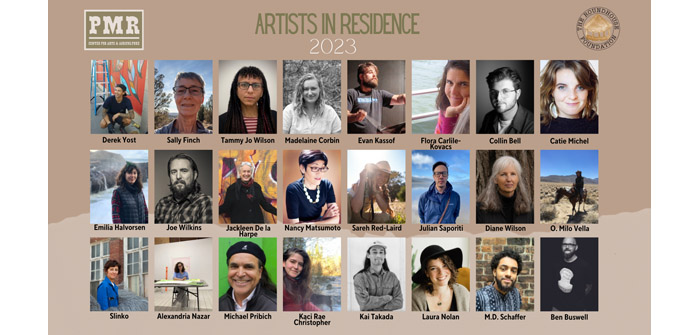(Photos courtesy of Pine Meadow Ranch Center for Arts and Agriculture)
Pine Meadow Ranch Center for Arts and Agriculture (PMRCAA) is excited to announce its 2023 residency participants. Through a juried application process, 24 artists, culture bearers, scientists, scholars and researchers from around the United States have been selected for either one-month or two-week stays at PMRCAA in Sisters from March through November. PMRCAA offers dedicated individuals a supportive environment in which to further their creative development. This year will be PMRCAA’s fifth residency program.
Through an open-call process applicants were invited to focus on the theme of Food & Agriculture. The topic connects the residency program with much of the work of parent organization, The Roundhouse Foundation, particularly in the agricultural sector.
“Agricultural practices are adapting and/or adopting new techniques to deal with the current environmental and social challenges,” said PMRCAA’s Arts Projects Coordinator Ana Varas. “By inviting participants who focus on the different components of the food system, we aim to foster critical thinking, dialogue and exchange of ideas and knowledge, which can lead to potential solutions to some of the environmental and social problems we are facing today.”
Residents will develop work around this year’s theme and work closely with others in the broader local region that are already engaging in community-supported agri(cultural) initiatives. PMRCAA also hosts a variety of community events around the scheduled residencies throughout the year, including lectures, workshops, open studios and roundtable talks. The 2023 residency participants include:
Visual Arts
Alexandria Nazar (Philadelphia, Pennsylvania): Paintings, drawings; received a Master’s in Painting and Drawing from the Tyler School of Art and Architecture in Philadelphia and a Bachelor’s in Fine Arts and History from the University of California, Davis.
Ben Buswell (Portland, Oregon): Sculptural work spans diverse media: glass, ceramics, metals, resins, and incised photographs.
Catie Michel (Denver, Colorado): Visual storyteller who explores the relationship with the natural world using artistic and scientific principles.
Collin Bell (Syracuse, New York): Documentary and portrait photographer, crafting images that explore vulnerable and complex themes regarding changing landscapes, non-traditional families and unexpected communities.
Derek Yost (Portland, Oregon): Painter and tattoo artist; work draws from a range of sources, including folk art, pre-Columbian art, wildlife and botany.
Flora Carlile-Kovacs (Seattle, Washington): Textile artist using an ancient textile technique of combining wool and silk fibers and fabrics with water and soap to create felt.
Laura Nolan (Bend) Uses a range of formats including sculpture, performance, community engagement and functional art.
Michael Pribich (New York City, New York): Visual artist who believes that in recognizing labor as cultural production, there becomes an expanded social space.
Sally Widgery Finch (Beaverton, Oregon): Visual artist working with weather and other information to see patterns over time; manipulates information to see it in new ways.
Tammy Jo Wilson (Oregon City, Oregon): Black artist and curator; Art in Oregon’s co-founder and president, Bush House Museum director of exhibits and programming, and Lewis & Clark College’s visual arts and technology program manager.
Performing Arts
Evan Kassof (Philadelphia, Pennsylvania): Composer based in Philadelphia whose work is at the intersection of opera, science and community building.
D. Schaffer (New York City, New York): A queer, non-binary, African-American writer, librettist and lyricist from Houston who lives in New York City. Their works examine the relationship between Americana, historical romanticism and contemporary American reality.
Literary Arts
Diane Wilson (Shafer, Minnesota): Author with a deep commitment to learning and writing about the relationship between humans and plants, water and land, and how that relationship has evolved over time.
Jackleen De la Harpe (Portland, Oregon): Writer who has worked primarily in journalism and nonfiction — essays, news and explanatory reporting.
Joe Wilkins (McMinnville, Oregon): Author of a novel, Fall Back Down When I Die; a memoir, The Mountain and the Fathers, and four collections of poetry, including When We Were Birds and Thieve.
Nancy Matsumoto (New York City, New York): Writer who covers food, agriculture and the environment. She co-authored Exploring the World of Japanese Craft Sake and edited a forthcoming book of Japanese poetry from UCLA’s Asian American Studies Press.
Multidisciplinary
Julian Saporiti and Emilia Halvorsen (Portland, Oregon): Perform as the musical duo No-No Boy. Saporiti transformed his doctoral research on Asian American history into concerts, albums and films with No-No Boy. As an artist and musician, Halvorsen teaches workshops around the world and her visual mediums include hand-embroidery, nature journaling and digital illustration.
Kaci Rae Christopher (Sisters): Sisters-based writer and garden educator focusing on fostering transformative experiences for youth through a connection to land.
Kai Takada Misner (Detroit, Michigan): Leader of Controlled Environment Agriculture Technology at Planted Detroit, a vertical hydroponic farm on the east side of the city.
Madelaine Corbin (Detroit, Michigan): Multidisciplinary artist; research-based practice moves fluidly between drawing, writing, sculpture, textiles and natural dyeing.
Milo Vella (Ithaca, New York): Works on research to support, and safeguard Indigenous and heritage-based agroecological systems.
Sarah Red-Laird (Ashland, Oregon): Conservationist, researcher, beekeeper, educator and artist; contemplating methods to creatively bring people to understand and appreciate the value of bees and healthy flower-filled landscape.
Slinko (Maplewood, New Jersey): Multidisciplinary artist from Ukraine living in the U.S.; practice is informed by scholarship on labor, agency and power, inspired by interactions with ordinary people, localized contexts and material culture.
About Pine Meadow Ranch Center forArts and Agriculture:
Pine Meadow Ranch Center for Arts and Agriculture (PMRCAA) is located on the historic Pine Meadow Ranch, a 260-acre working ranch in Sisters, Oregon at the base of the Cascade Mountains. The vision of PMRCAA is to connect sustainable agriculture, conservation arts and sciences with traditional and contemporary crafts and skills integral to ranching life. Located in the traditional territory of the Wasco, Warm Springs, and Paiute peoples, work at the ranch is grounded in a strong sense of place and community, and the diversity and multiple perspectives of the people that call our region home are deeply valued. Today, Pine Meadow Ranch operates as a program of the Sisters-based Roundhouse Foundation, and it continues to operate as a working ranch.





